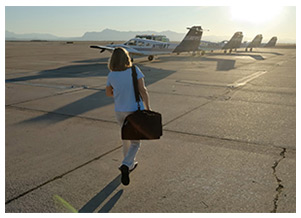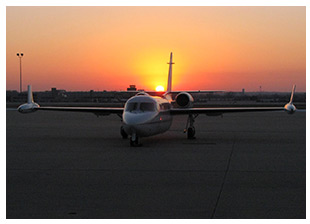Training Tips
|

Maximum solo
With a first solo happily in the books—as many student pilots proudly proclaim on AOPA's Flight Training Facebook page—and several more logged under similar conditions, the day comes when a student pilot solos on a day unlike those of previous flights.
Today there's an overcast at 5,000 feet, and a bit of wind. Not so unusual, except that the wind is from the "other" direction, the one opposite the airport's prevailing breezes. That means you will perform your takeoff and landing (or two, or three) way down there at that seldom-used runway end that is mostly foreign even to pilots who have flown here forever.
Don't underestimate the value of that scenario. The change of pace can deliver some of the same lessons as the cross-countries you will fly later, minus the time and fuel burn of longer flights.
One such lesson shows up when you prepare for the first landing. Landmarks and other cues that help you fly the traffic pattern to the more-familiar runway no longer apply. You must rely solely on your judgment to keep pattern-leg lengths reasonable and maintain correct spacing from the runway.
That effect mimics a cross-country because landing at an unfamiliar airport, with a new and different sight picture in the windscreen, demands more pilot attention to the task of controlling the descent rate on final approach. If you have been receiving guidance from a visual approach slope indicator on the usual runway, its supportive presence may be absent now.
Also, terrain features may require a modified or truncated traffic pattern. That terrain, and trees and buildings, can stir up mechanical turbulence down low.
Speaking of cross-countries, here is another way to maximize the experience provided by your solo flying. For pilots training at many airports, a provision of the regulations offers a workable option by permitting your instructor to authorize solo flights "to another airport that is within 25 nautical miles from the airport where the student pilot normally receives training," if the purpose of the flights is to "practice takeoffs and landings at that other airport." (Review the regulation and its limitations.)
Achieving solo is a landmark accomplishment, and follow-up solos are an exhilarating confirmation of your progress. Learning also soars, so be sure to take the opportunities your training environment offers to maximize the value of the solo hours that go in your logbook.
|
|
|
|
Flight Training News
|
|
Article
The weather is clear and forecast to be VFR for a quick jaunt to your favorite hamburger hop some 30 miles away. Should you be on record with a preflight weather briefing? It might be a good idea. Find out why...
 
UND, SkyWest partner on cadet program
The University of North Dakota John D. Odegard School of Aerospace Sciences and SkyWest Airlines recently announced a partnership that will grant qualifying students a conditional offer of employment and final interview for a first officer position at the regional airline. The SkyWest Pilot Cadet Program will provide participating students with mentorship, information about being a SkyWest pilot, a retained hire date, and more.

Quiz
Hollywood has portrayed pilots in many ways: handsome and dashing (The Rocketeer), brave and resolute (Thirty Seconds over Tokyo), and slapstick or drunk (It's a Mad, Mad, Mad, Mad World). Take this fun quiz, brought to you by Pilot Insurance Center, to find out which famous actor in a leading movie role best reflects your own personality. Take the quiz...
Helo company expands to Hawaii
A helicopter tour company based in Las Vegas is opening a new location in Hawaii. Maverick Helicopters has announced plans to begin offering aerial tours of Maui starting in spring 2015. The Maui location will be the fifth permanent base for Maverick Helicopters, which operates a fleet of more than 40 ECO-Star EC-130 helicopters, billed as the largest and youngest fleet of EC-130s in the world. The company offers charter and private tours, along with flying regular sightseeing routes over the Las Vegas strip and the Grand Canyon.
|
Training Resources
|
|
Login required
You discover the weight-and-balance document is not on board the aircraft. Can you legally fly the airplane without it? Check out the Air Safety Institute's Aircraft Preflight safety quiz for the answer and additional challenges that can pop up during preflight. Take the quiz...
|
Did you know that student pilots who join AOPA are three times more likely to complete their flight training? Membership includes unlimited access to aviation information by phone (800/USA-AOPA, weekdays from 8:30 a.m. to 8 p.m. Eastern time) or from Flight Training Online or AOPA Online. If you're not already a member, join today and get the pilot's edge.
|
|
|
AOPA Live
|
|
AOPA Live This Week
See how AOPA staffers react to hypoxia in a simulated trip to Flight Level 300, and watch AOPA Senior Editor Dave Hirschman take a test pilot turn for a homebuilt's first flight. Also this week, an inside look at Aircraft Spruce. AOPA Live This Week®, Oct. 16...
 
|
|
Career Pilot
|
Boeing forecasts world air cargo to double
A recently released Boeing forecast projects that air cargo traffic will grow at a rate of 4.7 percent annually over the next two decades, and that air freight traffic will more than double by 2033. The company released its biennial World Air Cargo Forecast Oct. 7, noting that global air cargo traffic began to grow in the second quarter of 2013 after a period of stagnation.
|
|
For more aviation career news, see the Flight Training website.
|
|
|
Plane Spotter
|

Commander's kin
Even with the most distinct lines, an aircraft sometimes hints at its heritage by its resemblance to a far-removed relative. On paper, the familiar high-winged piston twin Aero Commander 500 and the mid-winged Westwind bizjet—with its tip tanks and, on some models, winglets—might not seem even distantly derivative. But it turns out the twin's fuselage spurred the design of the Jet Commander, which became the Westwind, as it was renamed after Israel Aircraft Industries purchased the design. If winglets are present, you have spotted a model 1124A.
|
Training Products
|
|
PDF
Student pilots can download the FAA's technical manual Airplane Flying Handbook as a free PDF from the agency's website. Download it to your tablet to take it with you on the go and read about flight maneuvers, airport traffic patterns, night operations, and more. Download it here...
|
|
Note: Products listed have not been evaluated by ePilot editors unless otherwise noted. AOPA assumes no responsibility for products or services listed or for claims or actions by manufacturers or vendors.
|
Member Benefits
|
|
Webinar
The only thing harder than choosing the right aircraft insurance is understanding aircraft insurance. Cher Clare from AOPA Insurance Services will provide answers to all of your insurance-related questions during a webinar, Aircraft Insurance 101, on Oct. 23 at 8 p.m. Eastern time. Register now...
 
Members only
The federal aviation regulations dictate required use of supplemental oxygen, but go beyond the FAR/AIM and know your own physiology to help keep yourself safe at altitude. Read more...
 
|
|
|
Blogs
|
|
Job interviews at an airline or charter company may include a session evaluating the candidate's flying skills using a simulator or desktop training device. Frequently, it's this part that rattles applicants' nerves. What to do? Blogger Chip Wright offers tips. Read more...
 
|
|
|
Instrument Tip
|
|
IFR Fix
Some weather, a self-inflicted communications glitch, and the distraction of diverting had forged the error chain. Read more...
 
|
Final Exam
|
Question
What is the agonic line?
Answer
The agonic line is the line that connects points aligned with true north and magnetic north where there is no magnetic variation. (Source: Pilot's Handbook of Aeronautical Knowledge Chapter 15.)
|
|
Got a question for our technical services staff? Contact AOPA.
|
Career Opportunities
|
|
Aviation job board
Under the direction of the director of Ohio State University Airport, the director of flight education is responsible for managing the daily operations of the Ohio State University, College of Engineering's Flight Education Division. The Flight Education Division consists of a fleet of 17 aircraft and approximately 15 instructors. Training takes place at the Ohio State University Airport (Don Scott Field). Ohio State's airport is certificated by the FAA for commercial service, and is a general aviation reliever airport for the Port Columbus International Airport. Read the full job description...
AOPA career opportunities
Ever dream of turning your passion for aviation into a career? We're looking for a .Net applications developer, social media evangelist, executive assistant for accounting/finance and legal, legal services plan program manager, and account manager II. To learn more about other AOPA career opportunities, visit AOPA Online.
|
 |
Education and Seminars
|
Flight Instructor Refresher Courses
Oct 18-19 - Columbia, South Carolina
Oct 25-26 - Windsor Locks, Connecticut; Fort Lauderdale, Florida; and Wichita, Kansas
Nov 1-2 - Albuquerque, New Mexico; and Ashburn, Virginia
Nov 8-9 - Atlanta, Georgia; and San Diego, California
For a complete schedule, see AOPA Online. Can't make it in person? Sign up for the Air Safety Institute's new Online eFIRC.
|
Air Safety Institute Safety Seminars
Oct 20 - Eugene, Oregon
Oct 21 - Portland, Oregon
Oct 22 - Seattle, Washington
Nov 5 - West Lafayette, Indiana
Topics vary—for details and a complete schedule, see AOPA Online.
|
Rusty Pilot Seminars
Oct 18 - Chickasha, Oklahoma; and Claredon, Vermont
Oct 24 - Verdi, Nevada
Oct 25 - Spanish Fork, Utah
Nov 7 - St. Simons Island, Georgia
For a complete schedule, see AOPA Online.
|
|
|
|
|
|
|
|
 |
|
|
ePilot Flight Training Editors:
Sarah Deener
Alyssa Miller
Jim Moore
Production Assistant:
Melissa Whitehouse |
Contributors:
Jill W. Tallman
Warren Morningstar
Alton K. Marsh
Dave Hirschman
Tom Horne
Ian J. Twombly
Dan Namowitz |
|
|
|
|